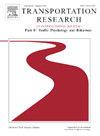听觉-认知和视觉-手动分心风险特征及其对驾驶影响的分析与比较
IF 3.5
2区 工程技术
Q1 PSYCHOLOGY, APPLIED
Transportation Research Part F-Traffic Psychology and Behaviour
Pub Date : 2024-11-01
DOI:10.1016/j.trf.2024.11.002
引用次数: 0
摘要
分心驾驶是造成交通事故的最重要原因之一,因此有 162 个国家制定了控制分心驾驶的法规,主要是禁止或限制使用手机。目前,还没有规范手机或其他分心行为的标准。了解常见分心驾驶行为的具体风险特征对于制定法规至关重要。然而,在比较常见分心驾驶行为的风险特征方面,研究还很有限。因此,本研究旨在分析和比较几种听觉-认知分心和视觉-手动分心的风险特征,以及驾驶员个人的具体因素。横向位置和加速度这两个碰撞代用指标被分为三个风险等级。分析车道保持事件时使用了偏比例几率模型,分析速度控制事件时使用了混合效应对数模型。模型结果表明,与无分心基线相比,视觉-手动分心任务会破坏驾驶员的车道控制和速度控制,而听觉-认知分心对车道保持的影响很小;听觉-认知分心比视觉-手动分心显示出更小的最大减速风险,但显示出更大的最大加速风险。此外,研究还发现,老年和女性驾驶员在分心时最大加速的风险更高,老年驾驶员在分心时车道偏离的风险更高。这些结果为制定分心驾驶法规提供了数据支持。本文章由计算机程序翻译,如有差异,请以英文原文为准。
Analysis and comparison of auditory-cognitive and visual-manual distraction risk characteristics and their effect on driving
Distracted driving is one of the most important causes of traffic crashes, leading 162 countries to establish regulations to control distracted driving, mainly by prohibiting or limiting the use of mobile phones. At present, there is no standard for regulating cellphones or other distractions. Understanding the specific risk characteristics of common distracted driving behaviors is crucial for regulatory development. However, research has been limited in comparing the risk characteristics of common distractions. Hence, this study aims to analyze and compare the risk characteristics of several auditory-cognitive and visual-manual distractions, as well as factors specific to individual drivers. Two crash surrogate indicators, lateral position and acceleration, were categorized into three risk levels. The partial proportional odds model was used to analyze lane keeping events, and the mixed-effects logit model was used for speed control events. Model results showed that, compared with the no-distraction baseline, visual-manual distraction tasks undermined both driver lane control and speed control, while auditory-cognitive distraction had little effect on lane keeping; auditory-cognitive distractions showed less risk of max deceleration than visual-manual distractions, but showed more risk of max acceleration. Additionally, it was found that older and female drivers have a higher risk of max acceleration when distracted, and older drivers have a higher risk of lane departure when distracted. These results provide data support for the development of distracted driving regulations.
求助全文
通过发布文献求助,成功后即可免费获取论文全文。
去求助
来源期刊
CiteScore
7.60
自引率
14.60%
发文量
239
审稿时长
71 days
期刊介绍:
Transportation Research Part F: Traffic Psychology and Behaviour focuses on the behavioural and psychological aspects of traffic and transport. The aim of the journal is to enhance theory development, improve the quality of empirical studies and to stimulate the application of research findings in practice. TRF provides a focus and a means of communication for the considerable amount of research activities that are now being carried out in this field. The journal provides a forum for transportation researchers, psychologists, ergonomists, engineers and policy-makers with an interest in traffic and transport psychology.

 求助内容:
求助内容: 应助结果提醒方式:
应助结果提醒方式:


